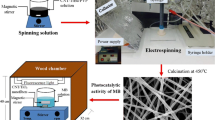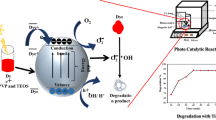Abstract
In this work, modelling of the photocatalytic degradation of para-nitrophenol (PNP) using synthesized electrospun TiO2 nanofibers under UV light illumination is reported. A dynamic model was developed in order to understand the behaviour of operating parameters, i.e. light intensity and catalyst loading on the photocatalytic activity. This model was simulated and analysed for both TiO2 solid nanofibers and TiO2 hollow nanofibers, applied as photocatalysts in the Langmuir–Hinshelwood kinetic framework. The entire photocatalytic degradation rate follows pseudo-first-order kinetics. The simulated results obtained from the developed model are in good agreement with the experimental results. At a catalyst loading of 1.0 mg mL−1, better respective degradation rates were achieved at UV light irradiance of 4 mW cm−2, for both the TiO2 solid and hollow nanofibers. However, it was also observed that TiO2 hollow nanofibers have a higher adsorption rate than that of TiO2 solid nanofibers resulting in a higher photocatalytic degradation rate of PNP.



Similar content being viewed by others
References
Aarthi T, Madras G (2007) Photocatalytic degradation of rhodamine dyes with nano-TiO2. Ind Eng Chem Res 46:7–14
Alves de Lima RO, Bazo AP, Salvadori DMF, Rech CM, de Palma Oliveira D, de Aragão Umbuzeiro G (2007) Mutagenic and carcinogenic potential of a textile azo dye processing plant effluent that impacts a drinking water source. Mutat Res 626:53–60
Andreozzi R, Caprio V, Insola A, Longo G, Tufano V (2000) Photocatalytic oxidation of 4-nitrophenol in aqueous TiO2 slurries: an experimental validation of literature kinetic models. J Chem Technol Biotechnol 75:131–136
Babuponnusami A, Muthukumar K (2014) A review on Fenton and improvements to the Fenton process for wastewater treatment. J Environ Chem Eng 2:557–572
Chilingarian GV, Torabzadeh J, Rieke HH, Metghalchi M, Mazzullo SJ (1992) Chapter 7 interrelationships among surface area, permeability, porosity, pore size, and residual water saturation. In: G.V. Chilingarian SJM, Rieke HH (Editors), Developments in petroleum science. Elsevier, pp. 379–397
Chin S, Park E, Kim M, Jurng J (2010) Photocatalytic degradation of methylene blue with TiO2 nanoparticles prepared by a thermal decomposition process. Powder Technol 201:171–176
Chong MN, Jin B (2012) Photocatalytic treatment of high concentration carbamazepine in synthetic hospital wastewater. J Hazard Mater 199–200:135–142
Chong MN, Jin B, Chow CWK, Saint C (2010) Recent developments in photocatalytic water treatment technology: a review. Water Res 44:2997–3027
Choquette-Labbé M, Shewa W, Lalman J, Shanmugam S (2014) Photocatalytic degradation of phenol and phenol derivatives using a nano-TiO2 catalyst: integrating quantitative and qualitative factors using response surface methodology. Water 6:1785
Chung KT, Fulk GE, Andrews AW (1981) Mutagenicity testing of some commonly used dyes. Appl Environ Microbiol 42:641–648
Daneshvar N, Salari D, Khataee AR (2003) Photocatalytic degradation of azo dye acid red 14 in water: investigation of the effect of operational parameters. J Photochem Photobiol A 157:111–116
Daneshvar N, Rabbani M, Modirshahla N, Behnajady MA (2004) Kinetic modeling of photocatalytic degradation of Acid Red 27 in UV/TiO2 process. J Photochem Photobiol A 168:39–45
Dutta S, Parsons SA, Bhattacharjee C, Jarvis P, Datta S, Bandyopadhyay S (2009) Kinetic study of adsorption and photo-decolorization of Reactive Red 198 on TiO2 surface. Chem Eng J 155:674–679
Eckert H, Bobeth M, Teixeira S, Kühn K, Cuniberti G (2015) Modeling of photocatalytic degradation of organic components in water by nanoparticle suspension. Chem Eng J 261:67–75
Goetz V, Cambon JP, Sacco D, Plantard G (2009) Modeling aqueous heterogeneous photocatalytic degradation of organic pollutants with immobilized TiO2. Chem Eng Process Process Intensif 48:532–537
Kanakaraju D, Glass BD, Oelgemöller M (2014) Titanium dioxide photocatalysis for pharmaceutical wastewater treatment. Environ Chem Lett 12:27–47
Kaneco S, Katsumata H, Suzuki T, Ohta K (2006) Titanium dioxide mediated photocatalytic degradation of dibutyl phthalate in aqueous solution—kinetics, mineralization and reaction mechanism. Chem Eng J 125:59–66
Konstantinou IK, Albanis TA (2003) Photocatalytic transformation of pesticides in aqueous titanium dioxide suspensions using artificial and solar light: intermediates and degradation pathways. Appl Catal B Environ 42:319–335
Li XZ, Zhao YG (1997) On-site treatment of dyeing wastewater by a bio-photoreactor system. Wat Sci Tech 36:165–172
Mehrotra K, Yablonsky GS, Ray AK (2003) Kinetic studies of photocatalytic degradation in a TiO2 slurry system: distinguishing working regimes and determining rate dependences. Ind Eng Chem Res 42:2273–2281
Minero C (1999) Kinetic analysis of photoinduced reactions at the water semiconductor interface. Catal Today 54:205–216
Misra M, Singh N, Gupta RK (2017) Enhanced visible-light-driven photocatalytic activity of Au@Ag core-shell bimetallic nanoparticles immobilized on electrospun TiO2 nanofibers for degradation of organic compounds. Catal Sci Tech 7:570–580
Mohammadi-Aghdam S, Marandi R, Olya ME, Mehrdad Sharif AA (2014) Kinetic modeling of BB41 photocatalytic treatment in a semibatch flow photoreactor using a nano composite film. J Saudi Chem Soc 18:317–326
Pendergast MM, Hoek EMV (2011) A review of water treatment membrane nanotechnologies. Energy Environ Sci 4:1946–1971
Reddy KR, Hassan M, Gomes VG (2015) Hybrid nanostructures based on titanium dioxide for enhanced photocatalysis. Appl Catal A Gen 489:1–16
Singh N, Mondal K, Misra M, Sharma A, Gupta RK (2016) Quantum dot sensitized electrospun mesoporous titanium dioxide hollow nanofibers for photocatalytic applications. RSC Adv 6:48109–48119
Terzian R, Serpone N (1995) Heterogeneous photocatalyzed oxidation of creosote components: mineralization of xylenols by illuminated TiO2 in oxygenated aqueous media. J Photochem Photobiol A 89:163–175
Tripathi KM, Tyagi A, Ashfaq M, Gupta RK (2016) Temperature dependent, shape variant synthesis of photoluminescent and biocompatible carbon nanostructures from almond husk for applications in dye removal. RSC Adv 6:29545–29553
Tyagi A, Tripathi KM, Singh N, Choudhary S, Gupta RK (2016) Green synthesis of carbon quantum dots from lemon peel waste: applications in sensing and photocatalysis. RSC Adv 6:72423–72432
Wei W, Qing Y, Yue C, Chang-lu S, Nan L, Xiao-tian L (2012) Preparation and photocatalysis of mesoporous TiO 2 nanofibers via an electrospinning technique. Chem Res Chin Univ 28:727–731
Yagub MT, Sen TK, Afroze S, Ang HM (2014) Dye and its removal from aqueous solution by adsorption: a review. Adv Colloid Interf Sci 209:172–184
Yu L, Xi J, Li M-D, Chan HT, Su T, Phillips DL, Chan WK (2012) The degradation mechanism of methyl orange under photo-catalysis of TiO2. PCCP 14:3589–3595
Zhong L, Haghighat F (2011) Modeling and validation of a photocatalytic oxidation reactor for indoor environment applications. Chem Eng Sci 66:5945–5954
Zhu T, Li Ong W, Zhu L, Wei Ho G (2015) TiO2 fibers supported β-FeOOH nanostructures as efficient visible light photocatalyst and room temperature sensor. Sci Rep 5:10601
Acknowledgements
RKG acknowledges financial assistance from the Department of Science and Technology (DST), India, through the INSPIRE Faculty Award (Project No. IFA-13 ENG-57) and Grant No. DST/TM/WTI/2K16/23(G). DST support is acknowledged to the Center for Nanosciences.
Author information
Authors and Affiliations
Corresponding author
Additional information
Responsible editor: Suresh Pillai
Rights and permissions
About this article
Cite this article
Singh, N., Rana, M.S. & Gupta, R.K. Modelling studies for photocatalytic degradation of organic dyes using TiO2 nanofibers. Environ Sci Pollut Res 25, 20466–20472 (2018). https://doi.org/10.1007/s11356-017-0053-8
Received:
Accepted:
Published:
Issue Date:
DOI: https://doi.org/10.1007/s11356-017-0053-8




